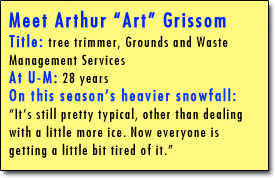The snow-weary campus community may be wondering if winter ever will end, but it’s not unusual to be plowing campus streets and sidewalks in March, says Arthur “Art” Grissom of Grounds and Waste Management Services (GWM).

“It’s still pretty typical, other than dealing with a little more ice. Now everyone is getting a little bit tired of it,” Grissom says. His job title is lead tree trimmer, but during winter he’s in charge of plowing snow after storms.
Every time a snowfall blankets campus, a crew of approximately 75 people works all night with a goal to clear the paths and roads by the next morning.
“A lot of people don’t realize what goes into removing all the snow and what goes on behind the scenes,” Grissom says.
When a snowstorm hits, Grissom and his crew are on the roads by 1 a.m., plowing streets, loading docks, ramps, sidewalks and the areas in front of classroom buildings. If there is too much snow to pile up along the curb line, it gets trucked off to a retention pond, where it melts in the spring. GWM shovels the remaining snow by hand.
“The grounds department really deserves credit,” Grissom says. “There are a lot of people involved in snow removal.”
The rest of the year Grissom is part of a five-member crew of certified arborists that takes care of the 7,000 or so trees on campus. He grew up on a farm in Chelsea, where he learned techniques for his future job. “We did a lot of tree removals and used the wood to heat the house,” he says.

After graduating from Chelsea High School, he worked in a local factory. When the economy turned sour and the shop had to close, he was hired at the University in Laundry Services. That was 28 years ago.
He left Laundry Services after a year-and-a-half and worked his way around various departments of GWM, including waste management and grounds keeping, until the outdoors lover found his niche as a tree trimmer.
Sometimes aggressive trimming of diseased and ice-damaged branches is necessary by the forestry crew to keep the trees healthy, Grissom says. “We try to reassure people that we’re just pruning for aesthetic purposes. Removing dead wood and thinning out branches actually helps the trees in the long run.”
Although most of his tree-related duties take place in the spring and summer months, he does have to remove the occasional tree that gets storm damage in the winter. He and his crew also trim the oak trees in the winter because of their susceptibility to oak wilt, a fungal disease that can spread in the summer.
Despite the still-cold temperatures, Grissom and the forestry crew will spend more time than usual on the Diag in the upcoming weeks preparing for April’s commencement ceremony.

